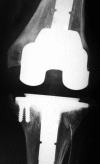Bone Defects in Revision Total Knee Arthroplasty and Management
- PMID: 30809942
- PMCID: PMC6430493
- DOI: 10.1111/os.12425
Bone Defects in Revision Total Knee Arthroplasty and Management
Abstract
This article reviews the recent updates in revision of total knee arthroplasty (RTKA). We reviewed the recent articles on RTKA in databases including PubMed, Google Scholar, and SCOPUS. Total knee arthroplasty (TKA) involves the replacement of all three compartments of the knee in surgery of the knee joint to restore capacity and function. TKA is one of the most common and reliable surgical treatment options for the treatment of knee diseases. However, some patients require revision of TKA (RTKA) after primary TKA for various reasons, including mechanical wear, implant loosening or breakage, malalignment, infection, instability, periprosthetic fracture, and persistent stiffness. Unfortunately, the overall outcome of RTKA is not as satisfactory as for primary TKA due to the uncertainty regarding the actual success rate and the risk factors for failure. Cementation, modular metal augmentation, bone grafting, autologous bone grafting, allogenic bone grafting, impactation bone grafting, structural bone allografting, metaphyseal fixation, using porous titanium coated press fit metaphyseal sleeves and porous tantalum structural cones, and megaprostheses or customized prostheses are the currently available management options for RTKA. However, most of the management systems possess specific complications. Novel approaches should be developed to improve functional capacity, implant survival rates, and quality of life in a cost-efficient manner.
Keywords: Bone defects; Knee joint pain; Management; Revision of total knee arthroplasty.
© 2019 The Authors. Orthopaedic Surgery published by Chinese Orthopaedic Association and John Wiley & Sons Australia, Ltd.
Figures











References
-
- Werner A, Jäger M, Schmitz H, Krauspe R. Joint preserving surgery for osteonecrosis and osteochondral defects after chemotherapy in childhood. Klin Padiatr, 2003, 215: 332–337. - PubMed
-
- Liddle AD, Judge A, Pandit H, Murray DW. Adverse outcomes after total and unicompartmental knee replacement in 101,330 matched patients: a study of data from the National Joint Registry for England and Wales. Lancet, 2014, 384: 1437–1445. - PubMed
-
- Van Manen MD, Nace J, Mont MA. Management of primary knee osteoarthritis and indications for total knee arthroplasty for general practitioners. J Am Osteopath Assoc, 2012, 112: 709–715. - PubMed
Publication types
MeSH terms
Grants and funding
- B2019188/Scientific Research Project of Health and Family Planning Commission of Hunan Province, China
- 2018JJ3844/Natural Science Foundation of Hunan Province, China
- 2017Q07/Youth Science Foundation of Xiangya Hospital Central South University
- 223551/Postdoctoral Research Program of Xiangya Hospital Central South University
LinkOut - more resources
Full Text Sources
Medical

